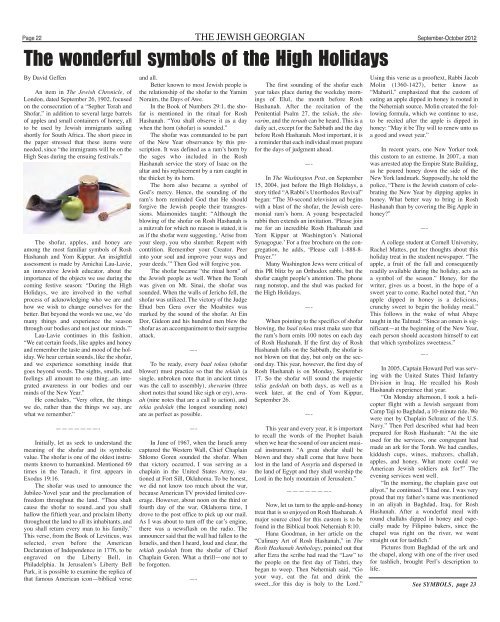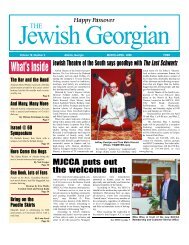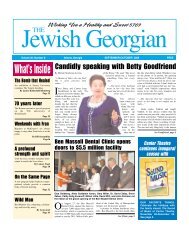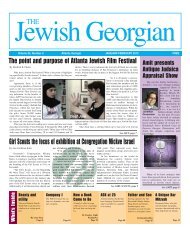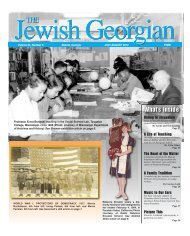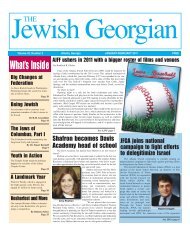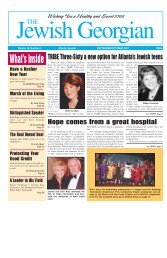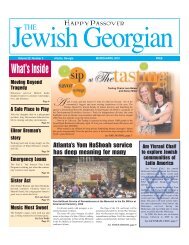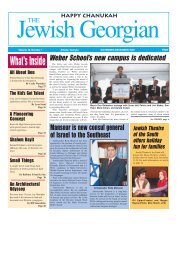mjcca news - The Jewish Georgian
mjcca news - The Jewish Georgian
mjcca news - The Jewish Georgian
Create successful ePaper yourself
Turn your PDF publications into a flip-book with our unique Google optimized e-Paper software.
Page 22 THE JEWISH GEORGIAN September-October 2012<br />
<strong>The</strong> wonderful symbols of the High Holidays<br />
By David Geffen<br />
An item in <strong>The</strong> <strong>Jewish</strong> Chronicle, of<br />
London, dated September 26, 1902, focused<br />
on the consecration of a “Sepher Torah and<br />
Shofar,” in addition to several large barrels<br />
of apples and small containers of honey, all<br />
to be used by <strong>Jewish</strong> immigrants sailing<br />
shortly for South Africa. <strong>The</strong> short piece in<br />
the paper stressed that these items were<br />
needed, since “the immigrants will be on the<br />
High Seas during the ensuing festivals.”<br />
<strong>The</strong> shofar, apples, and honey are<br />
among the most familiar symbols of Rosh<br />
Hashanah and Yom Kippur. An insightful<br />
assessment is made by Amichai Lau-Lavie,<br />
an innovative <strong>Jewish</strong> educator, about the<br />
importance of the objects we use during the<br />
coming festive season: “During the High<br />
Holidays, we are involved in the verbal<br />
process of acknowledging who we are and<br />
how we wish to change ourselves for the<br />
better. But beyond the words we use, we ‘do<br />
many things and experience the season<br />
through our bodies and not just our minds.’”<br />
Lau-Lavie continues in this fashion.<br />
“We eat certain foods, like apples and honey<br />
and remember the taste and mood of the holiday.<br />
We hear certain sounds, like the shofar,<br />
and we experience something inside that<br />
goes beyond words. <strong>The</strong> sights, smells, and<br />
feelings all amount to one thing...an integrated<br />
awareness in our bodies and our<br />
minds of the New Year.”<br />
He concludes, “Very often, the things<br />
we do, rather than the things we say, are<br />
what we remember.”<br />
———————-<br />
Initially, let us seek to understand the<br />
meaning of the shofar and its symbolic<br />
value. <strong>The</strong> shofar is one of the oldest instruments<br />
known to humankind. Mentioned 69<br />
times in the Tanach, it first appears in<br />
Exodus 19:16.<br />
<strong>The</strong> shofar was used to announce the<br />
Jubilee-Yovel year and the proclamation of<br />
freedom throughout the land. “Thou shalt<br />
cause the shofar to sound...and you shall<br />
hallow the fiftieth year, and proclaim liberty<br />
throughout the land to all its inhabitants, and<br />
you shall return every man to his family.”<br />
This verse, from the Book of Leviticus, was<br />
selected, even before the American<br />
Declaration of Independence in 1776, to be<br />
engraved on the Liberty Bell, in<br />
Philadelphia. In Jerusalem’s Liberty Bell<br />
Park, it is possible to examine the replica of<br />
that famous American icon—biblical verse<br />
and all.<br />
Better known to most <strong>Jewish</strong> people is<br />
the relationship of the shofar to the Yamim<br />
Noraim, the Days of Awe.<br />
In the Book of Numbers 29:1, the shofar<br />
is mentioned in the ritual for Rosh<br />
Hashanah. “You shall observe it as a day<br />
when the horn (shofar) is sounded.”<br />
<strong>The</strong> shofar was commanded to be part<br />
of the New Year observance by this prescription.<br />
It was defined as a ram’s horn by<br />
the sages who included in the Rosh<br />
Hashanah service the story of Isaac on the<br />
altar and his replacement by a ram caught in<br />
the thicket by its horn.<br />
<strong>The</strong> horn also became a symbol of<br />
God’s mercy. Hence, the sounding of the<br />
ram’s horn reminded God that He should<br />
forgive the <strong>Jewish</strong> people their transgressions.<br />
Maimonides taught: “Although the<br />
blowing of the shofar on Rosh Hashanah is<br />
a mitzvah for which no reason is stated, it is<br />
as if the shofar were suggesting, ‘Arise from<br />
your sleep, you who slumber. Repent with<br />
contrition. Remember your Creator. Peer<br />
into your soul and improve your ways and<br />
your deeds.’” <strong>The</strong>n God will forgive you.<br />
<strong>The</strong> shofar became “the ritual horn” of<br />
the <strong>Jewish</strong> people as well. When the Torah<br />
was given on Mt. Sinai, the shofar was<br />
sounded. When the walls of Jericho fell, the<br />
shofar was utilized. <strong>The</strong> victory of the Judge<br />
Ehud ben Gera over the Moabites was<br />
marked by the sound of the shofar. At Ein<br />
Dor, Gideon and his hundred men blew the<br />
shofar as an accompaniment to their surprise<br />
attack.<br />
—-<br />
To be ready, every baal tokea (shofar<br />
blower) must practice so that the tekiah (a<br />
single, unbroken note that in ancient times<br />
was the call to assembly), shevarim (three<br />
short notes that sound like sigh or cry), teruah<br />
(nine notes that are a call to action), and<br />
tekia gedolah (the longest sounding note)<br />
are as perfect as possible.<br />
—-<br />
In June of 1967, when the Israeli army<br />
captured the Western Wall, Chief Chaplain<br />
Shlomo Goren sounded the shofar. When<br />
that victory occurred, I was serving as a<br />
chaplain in the United States Army, stationed<br />
at Fort Sill, Oklahoma. To be honest,<br />
we did not know too much about the war,<br />
because American TV provided limited coverage.<br />
However, about noon on the third or<br />
fourth day of the war, Oklahoma time, I<br />
drove to the post office to pick up our mail.<br />
As I was about to turn off the car’s engine,<br />
there was a <strong>news</strong>flash on the radio. <strong>The</strong><br />
announcer said that the wall had fallen to the<br />
Israelis, and then I heard, loud and clear, the<br />
tekiah gedolah from the shofar of Chief<br />
Chaplain Goren. What a thrill—one not to<br />
be forgotten.<br />
—-<br />
<strong>The</strong> first sounding of the shofar each<br />
year takes place during the weekday mornings<br />
of Elul, the month before Rosh<br />
Hashanah. After the recitation of the<br />
Penitential Psalm 27, the tekiah, the shevarim,<br />
and the teruah can be heard. This is a<br />
daily act, except for the Sabbath and the day<br />
before Rosh Hashanah. Most important, it is<br />
a reminder that each individual must prepare<br />
for the days of judgment ahead.<br />
—-<br />
In <strong>The</strong> Washington Post, on September<br />
15, 2004, just before the High Holidays, a<br />
story titled “A Rabbi’s Unorthodox Revival”<br />
began: “<strong>The</strong> 30-second television ad begins<br />
with a blast of the shofar, the <strong>Jewish</strong> ceremonial<br />
ram’s horn. A young bespectacled<br />
rabbi then extends an invitation. ‘Please join<br />
me for an incredible Rosh Hashanah and<br />
Yom Kippur at Washington’s National<br />
Synagogue.’ For a free brochure on the congregation,<br />
he adds, ‘Please call 1-888-8-<br />
Prayer.”’<br />
Many Washington Jews were critical of<br />
this PR blitz by an Orthodox rabbi, but the<br />
shofar caught people’s attention. <strong>The</strong> phone<br />
rang nonstop, and the shul was packed for<br />
the High Holidays.<br />
—-<br />
When pointing to the specifics of shofar<br />
blowing, the baal tokea must make sure that<br />
the ram’s horn emits 100 notes on each day<br />
of Rosh Hashanah. If the first day of Rosh<br />
Hashanah falls on the Sabbath, the shofar is<br />
not blown on that day, but only on the second<br />
day. This year, however, the first day of<br />
Rosh Hashanah is on Monday, September<br />
17. So the shofar will sound the majestic<br />
tekia gedolah on both days, as well as a<br />
week later, at the end of Yom Kippur,<br />
September 26.<br />
—-<br />
This year and every year, it is important<br />
to recall the words of the Prophet Isaiah<br />
when we hear the sound of our ancient musical<br />
instrument. “A great shofar shall be<br />
blown and they shall come that have been<br />
lost in the land of Assyria and dispersed in<br />
the land of Egypt and they shall worship the<br />
Lord in the holy mountain of Jerusalem.”<br />
———————-<br />
Now, let us turn to the apple-and-honey<br />
treat that is so enjoyed on Rosh Hashanah. A<br />
major source cited for this custom is to be<br />
found in the Biblical book Nehemiah 8:10.<br />
Hana Goodman, in her article on the<br />
“Culinary Art of Rosh Hashanah,” in <strong>The</strong><br />
Rosh Hashanah Anthology, pointed out that<br />
after Ezra the scribe had read the “Law” to<br />
the people on the first day of Tishri, they<br />
began to weep. <strong>The</strong>n Nehemiah said, “Go<br />
your way, eat the fat and drink the<br />
sweet...for this day is holy to the Lord.”<br />
Using this verse as a prooftext, Rabbi Jacob<br />
Molin (1360-1427), better know as<br />
“Maharil,” emphasized that the custom of<br />
eating an apple dipped in honey is rooted in<br />
the Nehemiah source. Molin created the following<br />
formula, which we continue to use,<br />
to be recited after the apple is dipped in<br />
honey: “May it be Thy will to renew unto us<br />
a good and sweet year.”<br />
In recent years, one New Yorker took<br />
this custom to an extreme. In 2007, a man<br />
was arrested atop the Empire State Building,<br />
as he poured honey down the side of the<br />
New York landmark. Supposedly, he told the<br />
police, “<strong>The</strong>re is the <strong>Jewish</strong> custom of celebrating<br />
the New Year by dipping apples in<br />
honey. What better way to bring in Rosh<br />
Hashanah than by covering the Big Apple in<br />
honey?”<br />
—-<br />
A college student at Cornell University,<br />
Rachel Mattes, put her thoughts about this<br />
holiday treat in the student <strong>news</strong>paper. “<strong>The</strong><br />
apple, a fruit of the fall and consequently<br />
readily available during the holiday, acts as<br />
a symbol of the season.” Honey, for the<br />
writer, gives us a boost, in the hope of a<br />
sweet year to come. Rachel noted that, “An<br />
apple dipped in honey is a delicious,<br />
crunchy sweet to begin the holiday meal.”<br />
This follows in the wake of what Abaye<br />
taught in the Talmud: “Since an omen is significant—at<br />
the beginning of the New Year,<br />
each person should accustom himself to eat<br />
that which symbolizes sweetness.”<br />
—-<br />
In 2005, Captain Howard Perl was serving<br />
with the United States Third Infantry<br />
Division in Iraq. He recalled his Rosh<br />
Hashanah experience that year.<br />
“On Monday afternoon, I took a helicopter<br />
flight with a <strong>Jewish</strong> sergeant from<br />
Camp Taji to Baghdad, a 10-minute ride. We<br />
were met by Chaplain Schranz of the U.S.<br />
Navy.” <strong>The</strong>n Perl described what had been<br />
prepared for Rosh Hashanah: “At the site<br />
used for the services, one congregant had<br />
made an ark for the Torah. We had candles,<br />
kiddush cups, wines, mahzors, challah,<br />
apples, and honey. What more could we<br />
American <strong>Jewish</strong> soldiers ask for?” <strong>The</strong><br />
evening services went well.<br />
“In the morning, the chaplain gave out<br />
aliyot,” he continued. “I had one. I was very<br />
proud that my father’s name was mentioned<br />
in an aliyah in Baghdad, Iraq, for Rosh<br />
Hashanah. After a wonderful meal with<br />
round challahs dipped in honey and especially<br />
made by Filipino bakers, since the<br />
chapel was right on the river, we went<br />
straight out for tashlich.”<br />
Pictures from Baghdad of the ark and<br />
the chapel, along with one of the river used<br />
for tashlich, brought Perl’s description to<br />
life.<br />
See SYMBOLS, page 23


